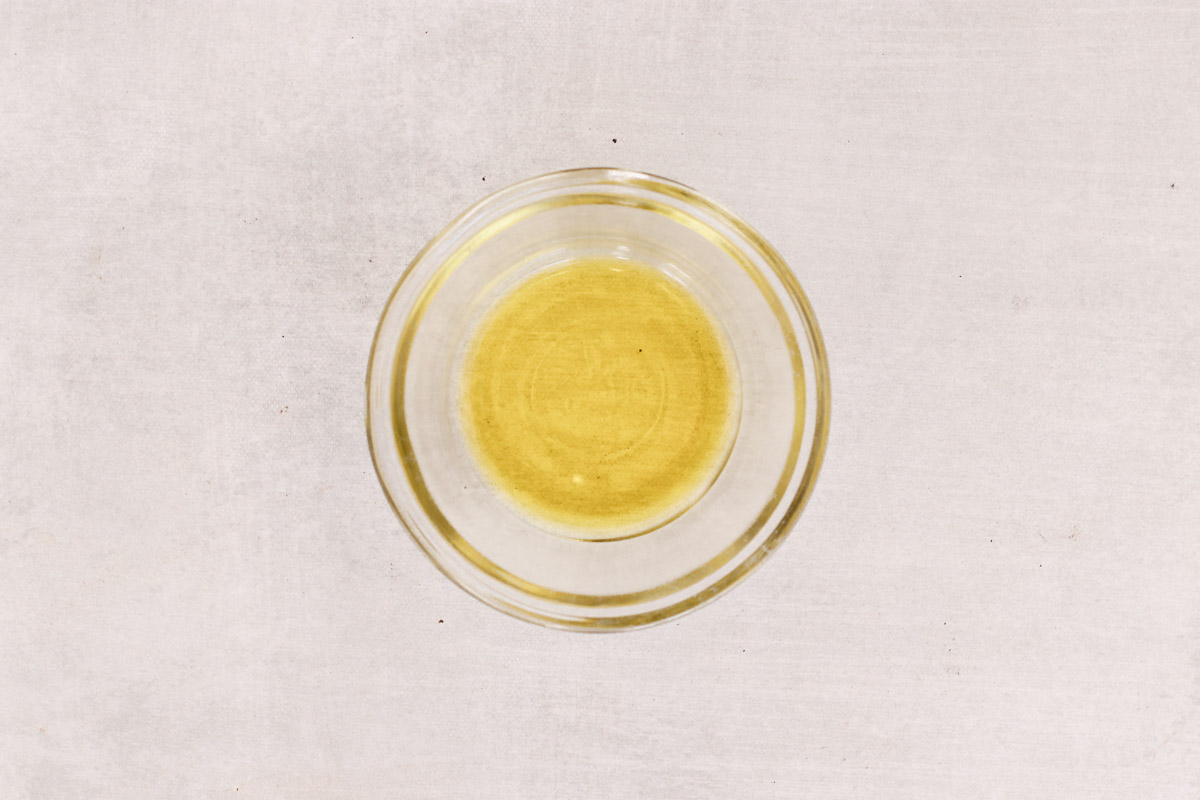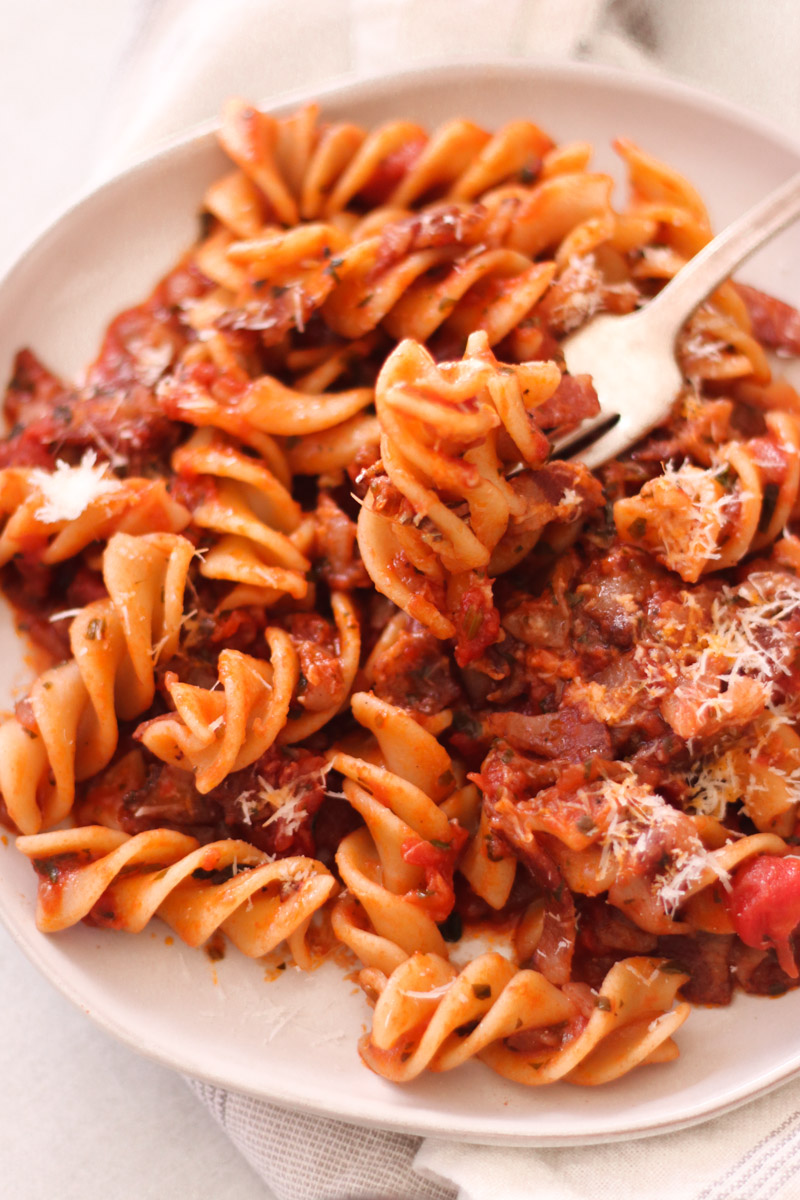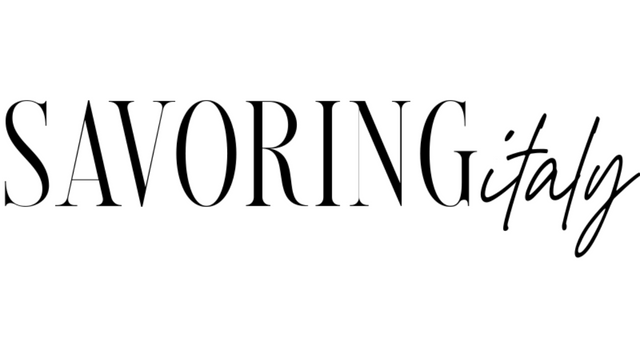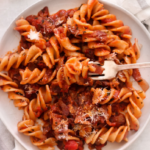Easy Pasta all’Amatriciana (Classic Roman Recipe): Try our rendition of the classic Italian amatriciana recipe. This delicious amatriciana sauce, otherwise known as all'amatriciana or matriciana, is prepared with crispy guanciale, canned Italian tomatoes, and topped with Pecorino Romano cheese. Ready in less than 30 minutes!

This article contains affiliate links which supports us at no extra cost to you.
Why you'll love sugo all amatriciana:
- Made with simple ingredients: Prepared with simple pantry staples, Amatriciana is one of my favorite pasta dinners. This delicious sauce is surprisingly easy to make, and just needs a handful of ingredients.
- Really fast: Ready in less than 30 minutes. This pasta recipe is quick to make!
- Make it spicy: If you enjoy a spicy Italian sauce, you could add some heat to this easy sauce.
Jump To
- Why you'll love sugo all amatriciana:
- How to pronounce amatriciana?
- What is Amatriciana?
- What is the authentic recipe of amatriciana?
- Amatriciana or matriciana
- What ingredients are in a Roman version of Amatriciana?
- How to make fusilli amatriciana?
- Expert tips for pasta all Amatriciana ricetta:
- Variations of pasta sauce Amatriciana:
- How to store leftovers?
- FAQs
- Some other pasta recipes to enjoy:
- Easy Pasta Amatriciana Roman Recipe
Today we are taking another trip to Rome in the Lazio region. This is the 3rd of the 4 classic Roman pasta recipes that I'm sharing here. The 4 Roman dream pasta dishes are: cacio e pepe, spaghetti alla carbonara, pasta Amatriciana, and pasta alla gricia (I’ll be making that next to share here soon!).
Amatriciana is traditionally made with bucatini or spaghetti. Rigatoni is another pasta that works. We used fussiloni, as it has curves and deep grooves that hold the sauce really nicely. Each bite of pasta is filled with the incredible sauce.
How to pronounce amatriciana?
Let’s say it together: Ama-Tree-Chee-Ana! Not only is the name so much fun to pronounce, this pasta recipe is one of the most delicious bites you’ll ever take in your life! Seriously!

There is hardly a day that goes by that we don't make a pasta recipe for lunch or dinner (sometimes both meals!). Pasta is so easy to put together and so economical. Simple ingredients with such flavorful results. You'll love to cook this recipe for guests.
This Italian pasta favorite has the most luscious and rich sauce that is made with smoky guanciale, onions, tomato sauce, and is topped with freshly grated pecorino romano cheese. If you like it spicy, go ahead and add a touch of chili pepper.
If you're looking for another recipe to add to your repertoire, like my slow cooker turkey Bolognese, this is one you will just love!

What is Amatriciana?
The name and recipe for Amatriciana originated in the town of Amatrice, in the region of Lazio back sometime in the 19th century. A 19th Century Roman chef Francesco Leonard wrote the recipe in a cookbook called "L’Apicio Moderno".
It was a recipe put together by shepherd's using ingredients they had on hand in the winter time. It actually derives from the recipe alla gricia, which is the white version of this sauce (not tomatoes!).
What is the authentic recipe of amatriciana?
If you would like to know exactly how they make it where the recipe was originated, you can read about it here comune di Amatrice. The original amatriciana was put together by shepherd's cooking over a fire using pasta, olive oil, white wine, guanciale, pecorino cheese, and some chili.
This is where the Italian purists will probably get into a food argument. Should it have onions or not? The Roman version may include the addition of onions and garlic, as well. I've seen recipes with onion + garlic together.
Amatriciana or matriciana
If you happen to be in Rome, you'll find the sauce called matriciana. Matriciana refers to the branding found on the back of the pig. The Roman version according to the Romans, is the considered the original recipe. Amatriciana or matriciana, you have to make this sauce!
What ingredients are in a Roman version of Amatriciana?
- Pasta – Bucatini is a traditional pasta used with this sauce. Bucatini has a hole in the center of the pasta. Spaghetti is also fine to use. Another common pasta is mezze maniche rigate. We used fusilloni. It’s a great pasta shape with twists and turns that will hold the delicious sauce.
- Olive Oil – A very good quality extra-virgin olive oil will make a difference in the flavor of the sauce. You could use a touch of the olive oil or a bit more. It's up to your taste.
- Guanciale – Guanciale is really important for this sauce. It’s not the same as bacon. Guanciale is the cheek (or jowl) of the pig and it’s used quite frequently in Roman recipes. Pancetta could be used in its place. If all you can get is bacon, use that.
- Onion – Onions is not in the traditional Amatrice version of this recipe. It’s found in Roman versions. Use it, or don’t use it. Marcella Hazan used an onion in her Essentials of Classic Italian Cooking book. I used a sweet onion. If I were in Italy, I would use a delicious Tropea onion from Calabria.
- Chilli – If you have a whole red chili (and don't mind some heat), toss that in the pan. Or you could sub some red chili flakes or even black pepper. Totally up to you and if you like it spicy.
- Wine – Wine is optional, not traditionally used We used red wine, but also white wine works. Make sure it’s a wine you actually drink. The wine helps to balance the smoky guanciale flavor. Cooking wine will not have the same flavor.
- Tomatoes – A (28-ounce) can whole Italian peeled San Marzano DOP tomatoes (or crushed) is what is used. Or you can use even a jar of tomato passata.
- Pecorino Romano – Used in many Roman dishes, this aged sheep’s milk cheese adds A bit more salty and earthy than Parmigiano-Reggiano (but go ahead and use Parmigiano-Reggiano if that’s what you have on hand). Marcella Hazan used a combo of both cheeses in Essentials of Classic Italian Cooking.
- Salt - Some coarse sea salt for the pasta water and a bit of fine sea salt for the sauce. The guanciale is very salty and so is the cheese, so check the sauce and start with a little bit of salt.
- Starchy pasta Water – The starchy pasta water is an essential part of many Italian pasta sauces. The starch helps the sauce to bind with the pasta, and also makes the sauce more smooth and silky.
How to make fusilli amatriciana?
Full printable recipe can be found below.

Forgot to include the oil in the group photo, so here it is below.

First step is to gather all the ingredients. Next, bring a pot of water to boil. Add salt when it comes to a boil.

In a large saute' pan, add the olive oil. When it is shimmering, add the guanciale and the onions. Cook until the guanciale gets crispy (about 10-15 minutes).

As soon as the guanciale is crispy, add the wine and deglaze the pan. Let it simmer together for a few minutes.

Next, add in the tomatoes. If I'm adding whole plum tomatoes, I like to break them up and remove the hard stem before I add them to the pan.
If using chili pepper, go ahead and add a little. Add the parsley and a little salt. Not too much salt. Start with a little bit, as the guanciale is salty. Let the sauce cook and simmer for 20-25 minutes. If it's too thick, ladle in a little bit of the pasta water.

Cook the pasta when you have about 10 minutes left for the sauce to simmer. Drain the pasta a couple minutes before it is al dente (reserve a cup of pasta water)and add it immediately to the pan with the sauce.
Stir it to combine on medium heat. Let the sauce coat the pasta. Let it simmer together for a minute (you want it to be al dente, not mushy), and plate up the pasta.

Serve with some Pecorino Romano cheese.

Expert tips for pasta all Amatriciana ricetta:
- Type of pasta to use: bucatini is the traditional pasta for this sauce. Spaghetti works fine. Also any short pasta, like rigatoni, penne, or mezze maniche (half rigatoni) will work as well
- Guanciale is essential: In case you can't find any, you can use pancetta. And it would be an amatriciana con pancetta. If you can't get guanciale or pancetta, you could use bacon.
- Hot pepper: Any fresh chili peppers are fine. Or hot pepper flakes. Use to your taste.
- Salt: Sea salt or kosher salt is fine. Salt the pasta water and check the seasoning of the sauce as it's cooking. The guanciale is salty, so start with a little bit of salt. Add more, if needed. You'll also be adding Pecroino, which is naturally salty, so keep that in mind.
Variations of pasta sauce Amatriciana:
- Roman: For the Roman version, olive oil is used. Some whole garlic cloves or onions.
- Amatrice: For the original Amatrice version, canned tomatoes (and not tomato passata), and some white wine to deglaze the pan when cooking the guanciale.

How to store leftovers?
- To Store: Any leftovers could be kept in an airtight container in the refrigerator for up to three days.
- To Freeze: The sauce will freeze nicely on its own for 2-3 months. I do not recommend freezing this pasta combined with the sauce.

FAQs
Yes, amatriciana sauce freezes very nicely. You could prep a big batch and separate the sauce in freezer safe containers (be sure to date the containers)and freeze for 2-3 months.
They are both tomato based sauces that are a bit spicy. Amatriciana is made with guanciale. Arrabiata is totally meat-free, so it is a vegan sauce.
Yes, the sauce could be prepped in advance. Let it cool down completely and store in the fridge for 2-3 days. When ready to enjoy, cook up the pasta. Heat the sauce in a skillet and combine with the pasta. Sprinkle on some Pecorino and enjoy.
In Amatrice, onion is not traditionally used. But in Roman recipes, you'll find onion as an ingredient in amatriciana.
Bucatini or spaghetti are used. Mezze maniche rigate is another shape or you could use fussili or what we used, fusilloni.
This famous sauce is said to have originated a thousand years ago by shepherds working out in the fields who would pieces of guanciale and a homemade hard cheese and pieces of guanciale. Originally it was a white sauce called gricia, and the people of Amatrice around 17-18th century added tomatoes.
The Village of Amatrice is located in Italy in the region of Lazio.
Yes, the authentic Amatriciana calls for olive oil to sauté the guanciale, which I do include in my recipe.
If you can't get a hold of pecorino Romano, you could use you could substitute with Parmigiano Reggiano. Keep in mind the flavor will change.
The name "Amatriciana” came about from the name of the Amatrice in Italy where the sauce is said to have been created.
An amatriciana is a traditional Italian sauce that features guanciale (salt-cured pork jowl), tomato, pecorino Romano, chili pepper flakes. The Roman version has onions. Some versions do make it with white wine.
It is pronounced ah-mah-tree-TCHAH-nah.
Some other pasta recipes to enjoy:
- Sicilian Pasta with Cauliflower
- Pasta alla Norma
- Orecchiette Pasta with Broccoli Sauce
- Ziti al Forno
Did you make this? Please RATE THE RECIPE below:)
Please Subscribe and give a follow on Instagram, Facebook, Pinterest, and TikTok xx
Originally published February 2023 and updated for content February 2024.
Easy Pasta Amatriciana Roman Recipe
Ingredients
- 1 lb of fusilloni (bucatini, spaghetti or rigatoni will work)
- 3 tablespoons extra-virgin olive oil
- 6 ounces guanciale cut into slices about 1/8 inch thick and then into 3/4- by 1/4-inch strips (see notes)
- 1 medium onion finely chopped (I used a sweet onion, Vidalia is fine)
- pinch red pepper flakes or a whole chili pepper
- ¼ cup red wine something you would drink
- 1 28-ounce can whole peeled tomatoes, crushed by hand or jar of tomato passata
- ¼ cup chopped fresh Italian parsley just the leaves
- sea salt to taste
- ½ cup grated Pecorino Romano cheese more, to your taste
Instructions
- Boil water: Bring a large pot of salted water to boil for the pasta.
- Prep the guanciale: Use a sharp knife to trim the thick bottom skin of the guanciale (discard or reserve it to flavor a soup). Cut the guanciale into slices about 1/8 inch thick and then into 3/4- by 1/4-inch strips (or into cubes).
- Heat the olive oil: In a large saute' pan, add the olive oil. When it is shimmering, add the guanciale and the onions. Cook until the guanciale gets crispy (about 10-15 minutes).
- Add the wine: As soon as the guanciale is crispy and renders its fat, add the wine and deglaze the pan. Let it simmer together on a medium-high heat for a few minutes.
- Add in tomatoes: Next, add in the tomatoes. Use your hands to break up the tomatoes (I like to remove the hard stem). Use a wooden spoon to stir and keep breaking the tomatoes. You could also use tomato passata. Lower the heat and let it simmer gently, stirring occasionally, until the sauce is dense, 20 to 30 minutes.
- Season with salt: If using chili pepper, go ahead and add a little. Add the parsley and a little salt. Start with a little bit of salt, as the guanciale is salty. Let the sauce cook and simmer for 20-25 minutes. If it's too thick, ladle in a little bit of the pasta water.
- Cook the pasta: When the sauce has about 10 minutes of time to simmer, cook the pasta. Set your timer to 2 minutes before the cook time.
- Simmer the sauce: While the sauce is simmering, if it seems too thick, ladle in a little bit of the pasta water.
- Drain the pasta: Drain the pasta a couple minutes before it is al dente (reserve a ½ cup of pasta water)and add the pasta immediately to the pan with the sauce.
- Combine pasta and sauce: Turn the heat to medium-high and stir to combine with the sauce and coat the pasta. Add in a little bit of the pasta water to loosen the sauce if it’s too thick. Let it simmer together for a minute (you want it to be al dente, not mushy), and plate up the pasta.
- Plate up the pasta: Serve with some Pecorino Romano cheese. Enjoy!
Nutrition Disclaimer
Please keep in mind that the nutritional information presented below is an approximation and may vary depending on the exact ingredients used.
Notes
- Guanciale- If you can find guanciale, do use it. Pancetta is a good substitute. Guanciale adds the rich, smoky flavor that is integral to the sauce.
- Starchy pasta water- Save some of the pasta water. A ladle could be added to the sauce while it's simmering if it's thickened too much.
- Sea salt - Use sea salt or kosher salt in the sauce. Not too much, as the guanciale is very salty. So taste the sauce before adding the salt, and adjust as needed.
- Pepper - Use hot chili pepper (whole or flaked) to your taste. You could also use freshly ground pepper, if you like.
- Make in advance - The sauce could be prepped ahead of time and stored in an airtight container in the fridge for 2-3 days.
- Storage - Any leftovers will stay fine in an airtight container for 2 days in the fridge.




Anne says
REALLY LOVE this recipe. Made this for lunch and it's delicious! Thank you!
Liz says
I remember one of my sons ordering this when we were in Rome! I had made it years ago, but it was fun for him to experience an authentic version. Next up will be YOUR recipe. xo
Lora says
Hi Lizzy-How cool your son tried it in Rome :)) THANK YOU...I hope you do make it! XXX